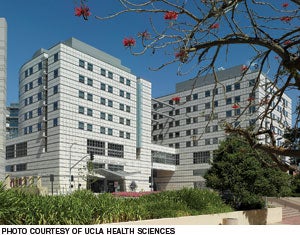What's delaying California's hospital projects?
While it won't solve the state's $25 billion budget deficit, critics say California may be sitting on an injection of economic relief from billions of dollars in hospital construction projects awaiting design approval from a state department.
 |
| Construction of the UCLA Medical Center was delayed for a variety of reasons, including a cutback in OSPHD staff, new building codes and plan revisions. |
But the department in question and others involved in the issue say that a confluence of factors, including complex, seismic-safety regulations, a state hiring freeze and inexperienced architects and designers, all contribute to the delays. Plus, the understaffed department bearing the brunt of the criticism insists it has approved billions in construction projects that sit idle.
While the issue is not new, it resurfaced recently when Jim Lott, executive vice president of the Hospital Association of Southern California, openly criticized the Office of Statewide Health Planning and Development (OSHPD) for its role in the approval delays.
Lott says that a backlog of $23 billion in hospital construction projects is caused largely by OSHPD taking an average of 15 months and sometimes longer to review and approve design plans before a project breaks ground. "These projects would generate about 232,000 jobs, pay $15.6 billion in wages and generate nearly $2 billion in state and local tax revenue," Lott says.
Anne Drumm, assistant director, legislative and public affairs, OSHPD, says the charge of excessive review time is inaccurate. Not only is there no $23 billion backlog, Drumm says, but OSHPD has approved $5.5 billion in projects under construction and another $3 billion awaiting start-up.
Numerous factors impact the review process, acknowledge those close to the issue. OSHPD is responsible for ensuring that new hospitals meet the state's Alfred E. Alquist Hospital Seismic Safety Act, which requires that a hospital remain operational during an earthquake, Drumm says.
That requirement has been challenging for the many out-of-state design firms, says Roger Richter, senior vice president, professional services, California Hospital Association.
Plus, Drumm says architecture and design firms hold onto plans about half of the time during the review process, which slows down the process. In addition, Richter says some firms indirectly let OSHPD design a project for them by intentionally providing incomplete plans or by cutting corners.
"We do agree with them that they don't shoulder the complete burden for the delay," Lott says about OSHPD.
In addition, OSHPD is badly understaffed due to a statewide hiring freeze. Lott is disturbed about 27 unfilled positions in OSHPD, particularly since the department is funded by hospitals, not the state. Furloughs for OSHPD staff are also a problem, he adds. Lott proposes a three-point plan that he believes would alleviate the delays without costing the state:
- Eliminate the furlough program for architects and engineers in OSHPD.
- Allow the office to fill the 27 budgeted vacancies for architects and engineers.
- Allow OSHPD to contract out for plan reviews until they can staff up.
Drumm points out that the department already has taken a number of steps to address the review process. One involves use of a phased plan review in which OSHPD staff work with the design team early in a project. This alone has cut approval times by an average of five months.
The department also plans to roll out a Web-based project tracking and reporting program later this year to improve the process. Also, the state now allows hospitals to meet seismic mandates more quickly by using risk-assessment software and voluntary structural improvements.




